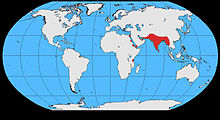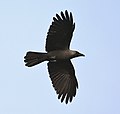House crow
| House crow | |
|---|---|

| |
| Corvus splendens ssp. zugmayeri at Desert National Park | |
| Scientific classification | |
| Domain: | Eukaryota |
| Kingdom: | Animalia |
| Phylum: | Chordata |
| Class: | Aves |
| Order: | Passeriformes |
| Family: | Corvidae |
| Genus: | Corvus |
| Species: | C. splendens
|
| Binomial name | |
| Corvus splendens Vieillot, 1817
| |

| |
The house crow (Corvus splendens), also known as the Indian, greynecked, Ceylon or Colombo crow,[2] is a common bird of the crow family that is of Asian origin but now found in many parts of the world, where they arrived assisted by shipping. It is between the jackdaw and the carrion crow in size (40 cm (16 in) in length) but is slimmer than either. The forehead, crown, throat and upper breast are a richly glossed black, whilst the neck and breast are a lighter grey-brown in colour. The wings, tail and legs are black. There are regional variations in the thickness of the bill and the depth of colour in areas of the plumage.
Taxonomy
[edit]The nominate race C. s. splendens is found in Pakistan, India, Nepal and Bangladesh and has a grey neck collar. The subspecies C. s. zugmayeri is found in the dry parts of South Asia and Iran and has a very pale neck collar. The subspecies C. s. protegatus is found in southern India, the Maldives (sometimes separated as maledivicus) and Sri Lanka and is darker grey. C. s. insolens, found in Myanmar, is the darkest form and lacks the grey collar.[3]
Distribution and habitat
[edit]It has a widespread distribution in southern Asia, being native to Nepal, Bangladesh, India, Pakistan, Sri Lanka, Maldives and Laccadive Islands, southern Myanmar, south Thailand, and coastal southern Iran. It was introduced to East Africa around Zanzibar (about 1897)[4] and Port Sudan. It arrived in Australia via ship but has up to now been exterminated. Recently, it has made its arrival in Europe and has been breeding in the Dutch harbour town Hook of Holland since 1998.
A population between 200 and 400 birds has been present in Sham Shui Po, New Kowloon, Hong Kong, in particular Lai Kok Estate and Sham Shui Po Park, as well as Kowloon Tsai Park in Kowloon Tsai.[5] An individual has been present in Cork Harbour on the south coast of Ireland since early September 2010.[6]
In the New World, a small population of house crows is established in the area around St. Petersburg, Florida.[7] As of April 2009, the introduced population of house crows in Socotra Island, Yemen, has been eradicated to avoid negative ecological effects to endemic species of Socotra.[8]
It is associated with human settlements throughout its range, from small villages to large cities. In Singapore, there was a density of 190 birds/km2 in 2001 with efforts to suppress the population in planning.[9][10]
Due to a human population explosion in the areas it inhabits, this species has also proportionately multiplied. Being an omnivorous scavenger has enabled it to thrive in such circumstances.
Invasive species
[edit]The invasive potential for the species is great all over the tropics. This species can make use of resources with great flexibility and appears to be associated with humans, and no populations are known to exist independently of humans. Based on niche-modelling it is estimated that it can also persist in some coastal areas in southern and northwestern Europe.[11] In 2016, house crow was added to the List of Invasive Alien Species of Union concern. The breeding population of this species is reported from Netherlands (Hoek van Holland), while individuals were seen in Belgium, Hungary, Poland and Spain.[12]
Behaviour
[edit]

Diet
[edit]House crows feed largely on refuse around human habitations, small reptiles and mammals,[13] and other animals such as insects and other small invertebrates, eggs, nestlings, grain and fruits. House crows have also been observed swooping down from the air and snatching baby squirrels. Most food is taken from the ground, but also from trees as opportunity arises. They are highly opportunistic birds and given their omnivorous diet, they can survive on nearly anything that is edible. These birds can be seen near marketplaces and garbage dumps, foraging for scraps. They have also been observed to eat sand after feeding on carcasses.[14]
Nesting
[edit]
At least some trees in the local environment seem to be necessary for successful breeding although house crows occasionally nest on telephone towers.[15] It lays 3–5 eggs in a typical stick nest, and occasionally there are several nests in the same tree. In South Asia they are parasitized by the Asian koel. Peak breeding in India as well as Peninsular Malaysia is from April to July. Large trees with big crowns are preferred for nesting.[16]
Roosting
[edit]House crows roost communally near human habitations and often over busy streets. A study in Singapore found that the preferred roost sites were in well-lit areas with a lot of human activity, close to food sources and in tall trees with dense crowns that were separated from other trees. The roost sites were often enclosed by tall buildings.[17] Before flying into roost trees, crows make pre-roosting aggregations perched on TV antennas, roof tops, wayside trees, open fields, and feed or preen during this time.[18]
Voice
[edit]The voice is a harsh kaaw-kaaw.[3]
Relationship to humans
[edit]
It is suspected that paramyxoviruses, such as PMV 1 that causes of Newcastle disease[19] may be spread by Corvus splendens. Outbreaks of Newcastle disease in India were often preceded by mortality in crows.[20] They have also been found to carry Cryptococcus neoformans, which can cause cryptococcosis in humans.[21]
House crows in Tanzania curiously showed an absence of blood parasites, although some species such as Trypanosoma corvi have been first described from this species.[22] Pathologist T.R. Lewis expressed surprise at the numbers of haematozoa present in the blood of house crows from Calcutta.[23]
Gallery
[edit]-
Grooming behaviour in India.
-
Grooming after bath in the rain in India.
-
Bathing in India.
-
House Crow swallowing bread in Kuala Lumpur.
-
Eating fish
-
In flight in Kolkata, West Bengal, India.
-
Assembling in the evening
-
In Bengaluru, India
-
House crow feeding chicks in Chennai, India
-
House crow fledgling
-
Collecting twigs for building a nest, Central Park (Kolkata)
-
House Crow (Corvus splendens zugmayeri) in Desert National Park
References
[edit]- ^ BirdLife International (2018). "Corvus splendens". IUCN Red List of Threatened Species. 2018: e.T22705938A131944731. doi:10.2305/IUCN.UK.2018-2.RLTS.T22705938A131944731.en. Retrieved 12 November 2021.
- ^ "House crow: animal pest alert". agric.wa.gov. Government of Western Australia: Department of Agriculture and Food. Retrieved 30 October 2015.
- ^ a b Rasmussen, PC & JC Anderton (2005) Birds of South Asia: The Ripley Guide. Smithsonian Institution and Lynx Edicions. Vol 2. p.598
- ^ Cooper, John E. (1996). "Health studies on the Indian house crow (Corvus splendens)". Avian Pathology. 25 (2): 381–386. doi:10.1080/03079459608419148. PMID 18645865.
- ^ [1] [2] [3] [4]
- ^ Ryall, C. 2016. Further records and updates of range extension in House Crow Corvus splendens. Bulletin of the British Ornithologists' Club 136(1):39-45
- ^ Pranty, W. 2004. Florida’s exotic avifauna: a preliminary checklist. - Birding, August 2004: 362:372.
- ^ Suliman, Ahmed Saeid; Meier, Guntram G.; Haverson, Peter J. (2010). "Eradication of Invasive House Crow (Corvus splendens) from Socotra Island, Republic of Yemen – Lessons Learned from 15 Years of Facing a Bird Invasion". Proceedings of the Vertebrate Pest Conference. 24 (24). doi:10.5070/V424110552. ISSN 0507-6773.
- ^ Brook, B.W., Sodhi, N.S., Soh, M.C.K., Lim, H.C. (2003) Abundance and projected control of invasive house crows in Singapore. Journal of Wildlife Management 67(4):808-817
- ^ Ryall, C., 2002. Further records of range extension in the House Crow Corvus splendens. BOC Bulletin 122(3): 231–240
- ^ Nyari, A., Ryall, C. and Peterson, A. T. 2006. Global invasive potential of the house crow Corvus splendens based on ecological niche modeling. J. Avian Biol. 37:306-311.
- ^ Ryall, C. 2010. Further records and updates of range extension in House Crow Corvus splendens. Bulletin of the British Ornithologists' Club 130(4):246-254
- ^ Mikula, P.; Morelli, F.; Lučan, R. K.; Jones, D. N.; Tryjanowski, P. (2016). "Bats as prey of diurnal birds: a global perspective". Mammal Review. 46 (3): 160–174. doi:10.1111/mam.12060.
- ^ Amey Jayesh Kambli (2004). "Geophagy by three species of crows near carcass dumping ground at Jodhpur, Rajasthan". Newsletter for Ornithologists. 1 (5): 71.
- ^ Lamba, B.S. 1963. The nidification of some common Indian birds. Part I. J. Bombay Nat. Hisl. Soc. 60:121-133
- ^ Soh MCK, NS Sodhi, RKH Seoh, BW Brook (2002) Nest site selection of the house crow (Corvus splendens), an urban invasive bird species in Singapore and implications for its management. Landscape and Urban planning 59:217-226
- ^ Kelvin S.-H. Peh and Navjot S. Sodhi (2002) Characteristics of Nocturnal Roosts of House Crows in Singapore. The Journal of Wildlife Management 66(4):1128-1133
- ^ Peh, Kevin S-H (2002). "Roosting behaviour of house crow (Corvus splendens) in relation to environmental variables" (PDF). The Raffles Bulletin of Zoology. 50: 257–262.
- ^ Roy, P., Venugopalan, A.T., Manvell, R. 1998 Isolation of Newcastle disease virus from an Indian house crow. Tropical animal health and production 30 (3):177-178
- ^ Blount, W.P. (1949). Diseases of Poultry. (London, Balliere, Tindall and Cox).
- ^ S. Gokulshankar, S. Ranganathan, M. S. Ranjith and A. J. A. Ranjithsingh (2004) Prevalence, serotypes and mating patterns of Cryptococcus neoformans in the pellets of different avifauna in Madras, India. Mycoses, 47:310–314
- ^ Dirie, M.F., Ashford, R.W., Mungomba, L.M., Molyneux, D.H. & Green, E.E. (1990). Avian trypanosomes in Simulium and sparrowhawks (Accipiter nisus). Parasitology, 101,243-247.
- ^ Lewis, Timothy Richards (1879). The microscopic organisms found in the blood of man and animals, and their relation to disease. Calcutta: Government Press. p. 71.
External links
[edit]- House Crow Monitor
- Bibliography from Corvids Literature Database
- House Crow Species text in The Atlas of Southern African Birds
- "House Crow media". Internet Bird Collection.
- Corvus splendens at Global Invasive Species Database Archived 2010-11-05 at the Wayback Machine
- House Crow photo gallery at VIREO (Drexel University)














